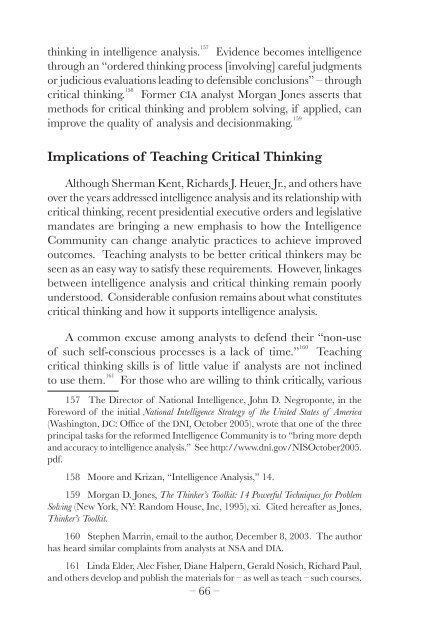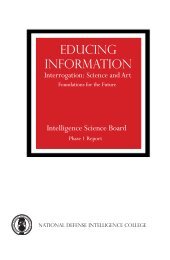Critical Thinking and Intelligence Analysis
Critical Thinking and Intelligence Analysis
Critical Thinking and Intelligence Analysis
You also want an ePaper? Increase the reach of your titles
YUMPU automatically turns print PDFs into web optimized ePapers that Google loves.
thinking in intelligence analysis. 157<br />
Evidence becomes intelligence<br />
through an “ordered thinking process [involving] careful judgments<br />
or judicious evaluations leading to defensible conclusions” – through<br />
critical thinking. 158<br />
Former CIA analyst Morgan Jones asserts that<br />
methods for critical thinking <strong>and</strong> problem solving, if applied, can<br />
improve the quality of analysis <strong>and</strong> decisionmaking. 159<br />
Implications of Teaching <strong>Critical</strong> <strong>Thinking</strong><br />
Although Sherman Kent, Richards J. Heuer, Jr., <strong>and</strong> others have<br />
over the years addressed intelligence analysis <strong>and</strong> its relationship with<br />
critical thinking, recent presidential executive orders <strong>and</strong> legislative<br />
m<strong>and</strong>ates are bringing a new emphasis to how the <strong>Intelligence</strong><br />
Community can change analytic practices to achieve improved<br />
outcomes. Teaching analysts to be better critical thinkers may be<br />
seen as an easy way to satisfy these requirements. However, linkages<br />
between intelligence analysis <strong>and</strong> critical thinking remain poorly<br />
understood. Considerable confusion remains about what constitutes<br />
critical thinking <strong>and</strong> how it supports intelligence analysis.<br />
A common excuse among analysts to defend their “non-use<br />
of such self-conscious processes is a lack of time.” 160<br />
Teaching<br />
critical thinking skills is of little value if analysts are not inclined<br />
to use them. 161<br />
For those who are willing to think critically, various<br />
157 The Director of National <strong>Intelligence</strong>, John D. Negroponte, in the<br />
Foreword of the initial National <strong>Intelligence</strong> Strategy of the United States of America<br />
(Washington, DC: Office of the DNI, October 2005), wrote that one of the three<br />
principal tasks for the reformed <strong>Intelligence</strong> Community is to “bring more depth<br />
<strong>and</strong> accuracy to intelligence analysis.” See http://www.dni.gov/NISOctober2005.<br />
pdf.<br />
158 Moore <strong>and</strong> Krizan, “<strong>Intelligence</strong> <strong>Analysis</strong>,” 14.<br />
159 Morgan D. Jones, The Thinker’s Toolkit: 14 Powerful Techniques for Problem<br />
Solving (New York, NY: R<strong>and</strong>om House, Inc, 1995), xi. Cited hereafter as Jones,<br />
Thinker’s Toolkit.<br />
160 Stephen Marrin, email to the author, December 8, 2003. The author<br />
has heard similar complaints from analysts at NSA <strong>and</strong> DIA.<br />
161 Linda Elder, Alec Fisher, Diane Halpern, Gerald Nosich, Richard Paul,<br />
<strong>and</strong> others develop <strong>and</strong> publish the materials for – as well as teach – such courses.<br />
– 66 –
















